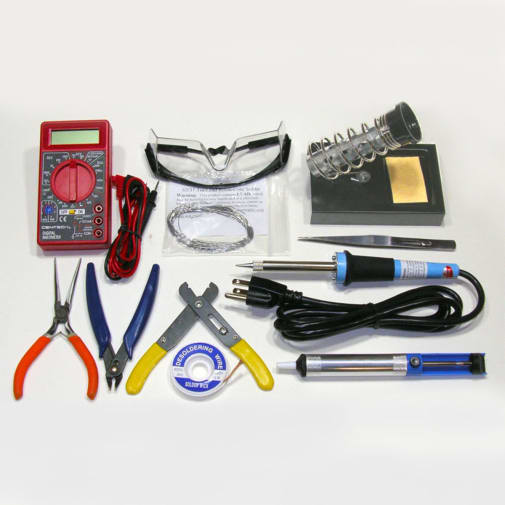We sell a variety of electronics kits with varying degrees of difficulty. While these kits are helpful in learning the basics of electronics, there is often a disconnect between understanding a circuit built with colorful snap-together plastic parts and seeing the same circuit made with real electronic parts soldered in place on a circuit board. Peter Miller has been working with the "real stuff" since first wielding a soldering iron at age 5. His favorite after-dinner activity was to pepper his knowledgeable father with technical questions. Peter kept right on learning - a physics major in college who has also learned chemistry, programming, mechanics, machining, glass blowing, jewelry making, plumbing, carpentry, welding, engineering, art, gardening and music.
This course focuses on learning real-world electronics using real-world components built with real-world tools. In the real world, things don't always go right, so Peter stresses following directions. Soldering can be undone, but it takes time and patience, so better to do it right the first time. Peter also stresses safety. The student is using a soldering iron, wire cutters, and components with pointed wire leads, so burns, cuts and minor shocks are possible.
In Part 1, the LED-Scope Kit, students learn how an oscilloscope works. Starting with a couple of bags of unidentified parts and two blank circuit boards, students will learn step by step about electronics and how to assemble these parts into a functioning oscilloscope. The instructions are contained in a series of PDFs on a CD-ROM. Besides text, the PDFs contain colorful charts, graphics, and photographs and hold the 17 chapters of Peter's instruction, which is where the course gets really interesting. Instead of simply having students find Part A and solder it into Position B on the circuit board, the well-rounded author starts with a discussion of what electricity is, what the different types of electricity are, which elements in the periodic table are the best conductors of electricity and why, a short history of why we use AC vs DC in our power grid, etc. And these are only some of the highlights in the first half of Chapter 1! The explanations are so clear and the background information so interesting that the student will want to continue to learn more. This approach also keeps the student from hurrying through building the kit just to get it done, but also helps the student retain the knowledge of what he is building because he will understand how it all came about. In the process of completing this kit, the student will also be doing the algebra required in electronics and learning to read and understand an electrical schematic diagram.
In Part 2, students will advance their learning as they build an LED Array Oscilloscope. Peter has heard (from students and employers) that, upon completion of this kit, a person would be qualified to work as an electronics technician with no additional training.
For your convenience, Peter offers a Tool Set containing the necessities for completing the kits. The set includes a soldering iron, cage-type soldering iron stand, ANSI safety glasses, wire stripper, flush/fine wire cutters, long nose pliers, 7" tweezers, 7-function digital multi-meter, solder sucker, desoldering braid, and solder. He estimates purchasing these tools separately would cost about $125.
If you want a taste of Peter's kits and teaching methodology, we offer some small single-purpose kits as well: Color Synthesizer, LED Warning Beacon, and LED Blinky Bread Board.
I met Peter and his lovely wife at a recent homeschooling convention in Cincinnati. Peter patiently explained to me his product line and his methodology for teaching electronics to others. But he wanted to get back to teaching the kids, who were lined up at his booth, waiting their turn to learn to use the soldering iron under his direction. Under his direction with these kits, your student will really learn and enjoy the study of electronics. - Bob

